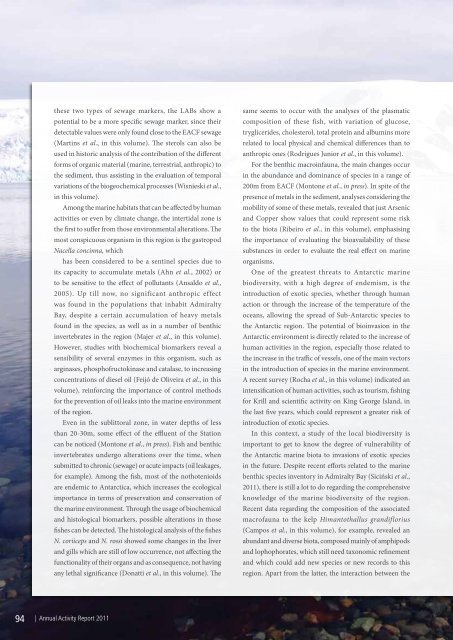1 - Instituto de Biologia da UFRJ
1 - Instituto de Biologia da UFRJ
1 - Instituto de Biologia da UFRJ
Create successful ePaper yourself
Turn your PDF publications into a flip-book with our unique Google optimized e-Paper software.
these two types of sewage markers, the LABs show a<br />
potential to be a more specific sewage marker, since their<br />
<strong>de</strong>tectable values were only found close to the EACF sewage<br />
(Martins et al., in this volume). The sterols can also be<br />
used in historic analysis of the contribution of the different<br />
forms of organic material (marine, terrestrial, anthropic) to<br />
the sediment, thus assisting in the evaluation of temporal<br />
variations of the biogeochemical processes (Wisnieski et al.,<br />
in this volume).<br />
Among the marine habitats that can be affected by human<br />
activities or even by climate change, the interti<strong>da</strong>l zone is<br />
the first to suffer from those environmental alterations. The<br />
most conspicuous organism in this region is the gastropod<br />
Nacella concinna, which<br />
has been consi<strong>de</strong>red to be a sentinel species due to<br />
its capacity to accumulate metals (Ahn et al., 2002) or<br />
to be sensitive to the effect of pollutants (Ansaldo et al.,<br />
2005). Up till now, no significant anthropic effect<br />
was found in the populations that inhabit Admiralty<br />
Bay, <strong>de</strong>spite a certain accumulation of heavy metals<br />
found in the species, as well as in a number of benthic<br />
invertebrates in the region (Majer et al., in this volume).<br />
However, studies with biochemical biomarkers reveal a<br />
sensibility of several enzymes in this organism, such as<br />
arginases, phosphofructokinase and catalase, to increasing<br />
concentrations of diesel oil (Feijó <strong>de</strong> Oliveira et al., in this<br />
volume), reinforcing the importance of control methods<br />
for the prevention of oil leaks into the marine environment<br />
of the region.<br />
Even in the sublittoral zone, in water <strong>de</strong>pths of less<br />
than 20-30m, some effect of the effluent of the Station<br />
can be noticed (Montone et al., in press). Fish and benthic<br />
invertebrates un<strong>de</strong>rgo alterations over the time, when<br />
submitted to chronic (sewage) or acute impacts (oil leakages,<br />
for example). Among the fish, most of the nothotenioids<br />
are en<strong>de</strong>mic to Antarctica, which increases the ecological<br />
importance in terms of preservation and conservation of<br />
the marine environment. Through the usage of biochemical<br />
and histological biomarkers, possible alterations in those<br />
fishes can be <strong>de</strong>tected. The histological analysis of the fishes<br />
N. coriiceps and N. rossi showed some changes in the liver<br />
and gills which are still of low occurrence, not affecting the<br />
functionality of their organs and as consequence, not having<br />
any lethal significance (Donatti et al., in this volume). The<br />
same seems to occur with the analyses of the plasmatic<br />
composition of these fish, with variation of glucose,<br />
trygliceri<strong>de</strong>s, cholesterol, total protein and albumins more<br />
related to local physical and chemical differences than to<br />
anthropic ones (Rodrigues Junior et al., in this volume).<br />
For the benthic macroinfauna, the main changes occur<br />
in the abun<strong>da</strong>nce and dominance of species in a range of<br />
200m from EACF (Montone et al., in press). In spite of the<br />
presence of metals in the sediment, analyses consi<strong>de</strong>ring the<br />
mobility of some of these metals, revealed that just Arsenic<br />
and Copper show values that could represent some risk<br />
to the biota (Ribeiro et al., in this volume), emphasising<br />
the importance of evaluating the bioavailability of these<br />
substances in or<strong>de</strong>r to evaluate the real effect on marine<br />
organisms.<br />
One of the greatest threats to Antarctic marine<br />
biodiversity, with a high <strong>de</strong>gree of en<strong>de</strong>mism, is the<br />
introduction of exotic species, whether through human<br />
action or through the increase of the temperature of the<br />
oceans, allowing the spread of Sub-Antarctic species to<br />
the Antarctic region. The potential of bioinvasion in the<br />
Antarctic environment is directly related to the increase of<br />
human activities in the region, especially those related to<br />
the increase in the traffic of vessels, one of the main vectors<br />
in the introduction of species in the marine environment.<br />
A recent survey (Rocha et al., in this volume) indicated an<br />
intensification of human activities, such as tourism, fishing<br />
for Krill and scientific activity on King George Island, in<br />
the last five years, which could represent a greater risk of<br />
introduction of exotic species.<br />
In this context, a study of the local biodiversity is<br />
important to get to know the <strong>de</strong>gree of vulnerability of<br />
the Antarctic marine biota to invasions of exotic species<br />
in the future. Despite recent efforts related to the marine<br />
benthic species inventory in Admiralty Bay (Siciński et al.,<br />
2011), there is still a lot to do regarding the comprehensive<br />
knowledge of the marine biodiversity of the region.<br />
Recent <strong>da</strong>ta regarding the composition of the associated<br />
macrofauna to the kelp Himantothallus grandiflorius<br />
(Campos et al., in this volume), for example, revealed an<br />
abun<strong>da</strong>nt and diverse biota, composed mainly of amphipods<br />
and lophophorates, which still need taxonomic refinement<br />
and which could add new species or new records to this<br />
region. Apart from the latter, the interaction between the<br />
94 | Annual Activity Report 2011

















